Easterlings, known in early times as Swarthy Men, were a race of Men who lived in the vast and uncharted lands of Rhûn, east of Mordor and the Sea of Rhûn. Easterlings were enemies of the Free Peoples and were allies of Sauron. There were many different nations and kingdoms of Easterlings living in the vast lands of Rhûn. These ranged from civilized empires to barbaric horse nomads of the open steppes.
Description
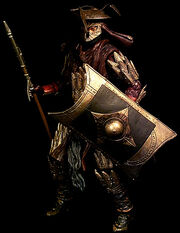
An Easterling, ready for battle
Easterlings, being of many different races and people, were either tall and sallow-skinned or short and swarthy. However, there were also said to be a different type of Easterlings that appeared during the Siege of Gondor from unknown eastern lands, who were broad, short, and bearded, and wielded axes like Dwarves. Easterlings were the most numerous and deadly of the enemies of the Free Peoples, and it is said if the Blue Wizards had not been sent into Rhûn the hosts of the East would have outnumbered the Western peoples. Their skin was either sallow (a pale yellow) or olive. Their eyes were dark (dark brown and black), and their straight hair was black. The "swarthier" Easterlings of the First Age and the Fourth Ages were not a related people, as those of the First came from the then-unknown lands east of the Blue Mountains, and could have had more relation to the Dunlendings than the later Balchoth and Wainriders.
History
First Age
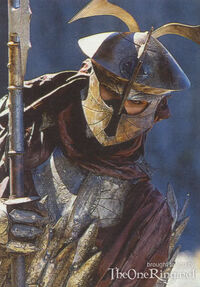
During the First Age, the term was applied to the sons of Bór and Ulfang, or the Swarthy Men, who came into Beleriand much later than the Edain, and who were for a part secretly in league with Morgoth.[1] By some men of Dor-lómin that appear in the Wanderings of Hurin, they are called Eastrons.
Bór was a leader of Men who came into Lothlann, in Beleriand, during the FA 463. His sons were Borlach, Borlad, and Borthand.[1] Bór was welcomed by Maedhros, who gave him and his followers land north and south of the March of Maedhros. Bór and his sons swore allegiance to Maedhros, and remained faithful, though he was told by Morgoth to betray the banner of Caranthir. All of them were wiped out during the Nirnaeth Arnoediad.[2]
Ulfang also came in Lothlann, Beleriand, in 463,[3] shortly after Bór. He was the father of Ulfast, Ulwarth, and Uldor "the Accursed". Ulfang was welcomed by the sons of Fëanor, and he and his sons swore allegiance to Caranthir. They were given lands to dwell in the north and south of the March of Maedhros. Ulfang and his sons were secretly in the employ of Morgoth, and betrayed the Eldar and Edain during the Nirnaeth Arnoediad in what is now known as the Treachery of Men.[2]
Rule in Hithlum
After Nirnaeth Arnoediad, at the bidding of Morgoth, the Easterlings invaded Hithlum. They spread throughout the wide lands plundering, destroying, and killing its inhabitants. The Eldar of Hithlum were able to escape from the invaders by taking refuge in the southern mountains that later the Easterlings avoided out of fear of the Elves. The Easterlings soon withdrew northwards and apparently settled.
However, the Easterlings were betrayed by their lord Morgoth, and locked solely in Hithlum and denied the rich lands of the Beleriand that they so desired. Here the Easterlings governed with cruelty, robbing, stealing, and enslaving the remaining Men of Hithlum, who called the Easterlings the " Incomers". They took away the young and the able bodied and sometimes young women to be wives; the most widely known being Aerin of whom Brodda took to produce his heir. Despite these evil deeds, they did not take Morwen nor her house from her for they feared her and believed her to be a witch and so her son had time to escape to Doriath. Tuor, the cousin of Túrin was also enslaved in Hithlum by the Easterlings but he was able to escape and evaded them by living as an outlaw, until he was contacted by the Vala Ulmo and went to Gondolin.[4][5]
The Easterlings ruled effectively in Hithlum as vassals of Morgoth from FA 473 to FA 583. After the War of Wrath, those that survived fled back over the Blue Mountains to Eriador and beyond where they sat themselves up as kings and chieftains of many of the Middle Men.[6]
Second Age
A King of the Easterlings, Khamûl, was given one of the Rings of Power and became a powerful sorcerer, until the power of the Ring corrupted him. Around SA 2251, Khamûl became a Wraith and one of Sauron's servants.[7]
Third Age
An Easterling during the Third Age
During the Third Age, the term was applied to the various nations and tribes of Men living in the uncharted lands east of the Sea of Rhûn and Mordor who were usually allied with Sauron (for one of their leaders was the second greatest of the Nazgûl, Khamûl) and frequently attacked Gondor and the lands bordering Rhûn. However, Sauron's defeat at the end of the War of the Last Alliance diminished his presence for over one thousand years, and any territorial ambition was left to them alone. In TA 490 they invaded Gondor, passing through Dagorlad and starting a series of wars that lasted sixty years until they were finally defeated in TA 550 by Turambar, the ninth King of Gondor. Afterwards, Gondor subdued some of them and took from them a large area of land between the Kingdom of Rhovanion and Mordor including the Sea of Rhûn.[8][9]
Gondor held on to these territories for a few hundred years but slowly began to lose them over time, and the Easterlings once again initiated warfare. In TA 1248 they once again clashed with Gondor in a series of skirmishes but were still not powerful or organized enough to stand against Gondor’s power.[8] Though defeated the Easterlings would not have to wait long, for Gondor soon fell into decline and civil war. Afterwards, the Easterling tribes remained peaceful for the most part until the mid-nineteenth century when they were again powerful enough to attack the west.
The War of the Ring
During the War of the Ring at the end of the Third Age, the Easterlings joined with the forces of Mordor participating in the Northern battles that nearly defeated the Elves of Mirkwood, Men of Dale, and the Dwarves of the Lonely Mountain.[10]
Despite being on the losing side in the war, some Easterlings still continued to remain a threat throughout the early Fourth Age but were finally subdued in a series of campaigns led by King Elessar. In these battles the Easterlings, aside from the hordes of Orcs, were the most numerous and tenacious of Sauron's warriors.
Specific groups
Wainriders
The Wainriders were a confederation of Easterling tribes who were united by their hate of Gondor, fueled by the Dark Lord Sauron. Following the Great Plague which weakened Gondor, they started their attacks in TA 1856, defeating a Gondor army at the Battle of the Plains and killing King Narmacil II. They rode in great chariots (which gave them their name), and raided the lands of Rhovanion, destroying or enslaving its people. Gondor gradually lost all of its possessions east of Anduin to them.
In TA 1899, the thirtieth King of Gondor, Calimehtar son of Narmacil, defeated the Wainriders at Dagorlad, buying some rest for his land. However the Wainriders struck back in TA 1944, allying themselves with the Haradrim of Near Harad and the Variags of Khand. Before this they had been expanding their power southward, beyond Mordor, and had come into conflict with the tribes of Khand and the eastern Haradrim. But eventually these men allied under their universal hate of the West. They managed to kill King Ondoher and all his heirs, but instead of riding on to Minas Anor and taking the city, they paused to celebrate.
Meanwhile, general Eärnil of Gondor's southern army rode north to defend his king defeating an inferior force of Haradrim in South Ithilien, he came too late to rescue Ondoher, but he did manage to annihilate the Wainriders for good at the Battle of the Camp. Eärnil was crowned king. After this defeat the might of the Wainriders was broken, and they retreated east. They still held Rhovanion, but never troubled Gondor again until the War of the Ring.[11][9][12]
Balchoth
The Balchoth were a fierce race of Easterlings, who attacked Gondor while under orders of Dol Guldur. In TA 2510, they overran the plains of Calenardhon and almost destroyed the army of the Ruling Steward Cirion, but were defeated by the Éothéod under Eorl the Young. Like the Wainriders they rode in chariots and wagons, and they may have been descendants of these people. However, they were notably far more primitive and savage than the advanced Wainriders, so their origin is at best obscure.
Weapons
Not much is known about the weapons used by the Easterlings. They had as far as it is known among their arsenal spears, bows, pikes, axes and chariots. They also seemed to favor the horse on many occasions, although all this probably differed greatly among the Easterling tribes, kingdoms, or empires.
Culture
Knowledge of the culture of the Easterlings is limited. In the First Age they could be quite savage; examples of this rise from Brodda's treatment of the Men of the House of Hador in Dor-lómin. In the Third Age at least, the Easterlings fought with great valor, as displayed during the Battle of the Pelennor Fields and the Battle of the Black Gate. The numerous clans of the Easterlings were united by Emperors and Kings of Rhûn (like Khamûl). An Emperor of the Easterlings was supposed to have led an army to the Battle of Dale and supported Sauron.
Portrayal in adaptations
The Lord of the Rings and The Hobbit film trilogies
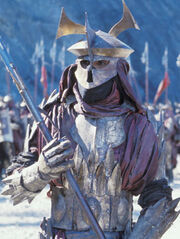
An "Easterling" at the Black Gate
In The Lord of the Rings: The Two Towers, an army from Rhûn is seen by Frodo, Gollum, and Sam entering the Black Gate. The corresponding passage in the book describes them as Easterlings; in the movie they are the same, quite distinct from the Haradrim passing through Ithilien later in the film. During this encounter, Sam accidentally falls down a slope near to where Easterlings are passing by. Frodo goes after him, and two Easterling warriors notice the commotion; they leave the formation to inspect. Frodo hides himself and Sam under his elvish cloak, disguising them as a boulder. The Easterling soldiers almost find them, but eventually return to their legion and march into Mordor.
In The Lord of the Rings: The Return of the King they are also seen briefly after the gate of Minas Tirith has been breached. There they advance upon the soldiers of Gondor, but they are not seen fighting.
The Hobbit: The Battle of the Five Armies depicts one of the Nazgûl in armor resembling that of the Easterlings; this is undoubtedly intended to be Khamûl.
Inspirations
In Peter Jackson's film series, the Easterlings are depicted as a heavily-stylized, vaguely Middle Eastern culture. This caused some controversy after the films were released. In the appendices of the Special Extended Edition of The Lord of the Rings: The Two Towers, the artists claim that they were inspired by a variety of Persian cultures, particularly Sassanid Persians, Mongol horsemen, and Ottoman Turks. They have "crests" on the backs of their hat-like helmets that resemble feudal Samurai crests. They also bear a rising sun emblem upon their armor. The full-body armor the Easterlings wear resembles armor which ancient Chinese soldiers wore. Beneath their armor they wear veils, headscarves, and robes. In some movie-models, their boots have upturned toes, suggesting a Mongolic, Turkic or Persian influence.
Video games
- Easterlings appear in The Lord of the Rings Online, in the Brown Lands bordering with the Parth Celebrant region, where they established a couple of settlements, and in many other regions south of this, where they threaten the eastern borders of Rohan and in some cases join in invaders of Gondor. They belong to a few tribes: the Balchoth, the Jangovar, the Khundolar, the Variags, and the Wainriders.
- Easterling pikemen are a unit in all three The Battle for Middle-earth games, available to the Mordor faction.
- In the Desolation of Mordor DLC for the video game Middle-earth: Shadow of War the mercenaries that the player character Baranor can hire are Eastlerlings. These Easterlings appear similar to those in the films.
Military in adaptations
The Lord of the Rings trilogy
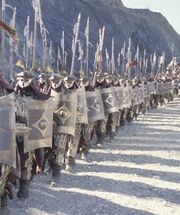
An Easterling army assembled for battle in full uniform with shields and spears
The armor of the Easterlings entering the Black Gates was made from bronze, along with the helmet; its dragon-skull-shape was made to intimidate enemies.
Their gold or brass overlayed steel lamellar armor consisted of a placard (stomach plate), gorget (heart & neck coverage), groin-plate, rerebraces (upper arm), vambraces (forearm), cuisses (thighs), and poleyns (knees). The clothing that the Men of Rhûn wore consisted of red leather gloves, black leather tall boots, burgundy long pants, a burgundy tunic with long sleeves, a burgundy headscarf, and a black facecloth . The undercut, brass helmet was worn over the headscarf, and featured cheek-and-eye guards, along with two horns from the back and a crest on the front, to remind other beings of dragons, intimidating to the enemy even before the battle began.
During battle, these heavy infantrymen formed the core of Sauron's armies, for they were taller and better-equipped than the swarming Orcs that fully comprised his forces.

The march of the Easterlings
The curved, rectangular, two-foot by three-foot Easterling shield had concave top and bottom edges and was made with brass that surrounded a dark-brown square. It was held by an iron handgrip that was behind a brass circular boss surrounded by a diamond shape that was itself enveloped by the square. It came with a dark-red leather "belt" if the Man of Rhûn was to strap the shield to the forearm for combat requiring two hands. Even archery was allowed by this big strap. One rather striking detail on Rhûnic armor was that a sun was etched into their sternum-plate, resembling a burning of a grassland such as Rohan or Dale.
The Lord of the Rings Strategy Battle Game
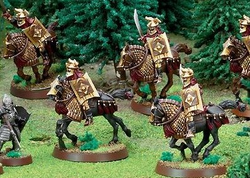
Easterling Kataphrakt models from The Lord of the Rings Strategy Battle Game
In The Lord of the Rings Strategy Battle Game, the Easterlings have a unique type of cavalry known as kataphrakts*. These were Easterlings mounted upon heavily armored horses and wielding a scimitar and broad shield. They were notorious for their ferocity of their attacks and defensive power when they were deployed side-by-side. The brass lamellar armor on the fronts of their horses allowed them to safely trample spearmen and pikemen. Rhunic composite short-bows were sometimes taken instead of shields.
Easterlings in full battle gear with the weapons they use, entering Mordor
Kataphrakts is from the ancient Greek derivative word Kataphraktos meaning "the armored", translating to Cataphract in English. Cataphracts were heavily armored cavalry used as elite troops or bodyguards. The Sassanid Persian Empire had elite troops called the "Savaran Cataphracts". Cataphracts are thought to have been developed as early as the 8th century B.C. by Middle Eastern cultures such as the Assyrians and Achaemenid Empire. Such heavy horse troops were integrated into the Roman Army sometime around the 2nd Century B.C. and became a distinct troop regiment by the time of Hadrian in the 2nd Century A.D.
Translations
| Foreign Language | Translated name |
| Afrikaans | Die Manne van die Ooste |
| Albanian | Burra të lindjes |
| Amharic | የምሥራቅ ሰዎች |
| Arabic | رجال الشرق |
| Armenian | Արեւելքի տղամարդիկ |
| Belarusian Cyrillic | Істэрлінг ? |
| Bengali | প্রাচ্যের পুরুষদের |
| Bosnian | Plemena s istoka |
| Bulgarian Cyrillic | Източни люде |
| Catalan | Homes de l'Est
Orientalencs |
| Chinese (Hong Kong) | 東方人 |
| Chinese (China) | 东夷 |
| Croatian | Plemena s istoka |
| Czech | Východňané |
| Danish | Østerlingene |
| Dutch | Oosterlingen |
| Finnish | Itäläiset |
| French | Orientaux |
| Georgian | ისტერლინგები (აღმოსავლელები) |
| German | Ostlinge |
| Greek | Ανατολίτες |
| Hebrew | בני המזרח |
| Hindi | पूर्व के पुरुषों |
| Hungarian | Keletlakók |
| Icelandic | Austmenn |
| Irish Gaelic | Fir an Oirthir |
| Japanese | 東夷 |
| Kannada | ಪೂರ್ವದ ಮೆನ್ |
| Kazakh | Шығыс ерлері (Cyrillic) Şığıs erleri (Latin) |
| Korean | 동부인 (이스터링) |
| Kurdish | Zilamên rojhilat (Kurmanji Kurdish) |
| Kyrgyz Cyrillic | Чыгыш адамдар |
| Latvian | Austrumnieks |
| Macedonian Cyrillic | Луѓе од исток |
| Marathi | पूर्व लोक |
| Mongolian Cyrillic | Дорно дахин эрчүүд |
| Norwegian | Austringene |
| Pashto | ختیځ نارینه |
| Persian | ایسترلینگها |
| Polish | Easterlingowie |
| Punjabi | ਪੂਰਬ ਦੇ ਪੁਰਸ਼ |
| Romanian | Oamenii din Est |
| Russian | Истерлинги |
| Scottish Gaelic | Fir an ear |
| Serbian | Источњаци (Cyrillic) Istočnjaci (Latin) |
| Sinhalese | නැගෙනහිර පුරුෂයන් |
| Slovak | Východniari |
| Slovenian | Moški na vzhodu |
| Spanish | Hombres del Este |
| Swedish | Östringar |
| Tajik Cyrillic | Мардони шариф |
| Tamil | கிழக்கு ஆண்கள் |
| Telugu | తూర్పు పురుషులు |
| Turkish | Doğulular |
| Ukrainian Cyrillic | Еастерлінґс |
| Uzbek | Чарқий эркаклар (Cyrillic) Sharqiy erkaklar (Latin) |
| Vietnamese | Đàn ông phương Đông |
| Welsh | Dynion y dwyrain |
| Xhosa | Madoda aseMpuma |
| Yiddish | מענטשן פון די מזרח |
| Yoruba | Awọn ọkunrin ti ila-õrùn |
| Zulu | Amadoda aseMpumalanga |
References
- ↑ 1.0 1.1 The Silmarillion, Quenta Silmarillion, Chapter XVIII: "Of the Ruin of Beleriand and the Fall of Fingolfin"
- ↑ 2.0 2.1 The Silmarillion, Quenta Silmarillion, Chapter XX: "Of the Fifth Battle: Nirnaeth Arnoediad"
- ↑ The History of Middle-earth, Vol. 5: The Lost Road and Other Writings, Part Two: "Valinor and Middle-earth before The Lord of the Rings"
- ↑ The Silmarillion, Quenta Silmarillion, Chapter XXIII: "Of Tuor and the Fall of Gondolin"
- ↑ Unfinished Tales, Introduction, Part One, I: "Of Tuor and his Coming to Gondolin"
- ↑ The Silmarillion, Quenta Silmarillion, Chapter XXIV: "Of the Voyage of Eärendil and the War of Wrath"
- ↑ The Lord of the Rings, Appendix B: The Tale of Years (Chronology of the Westlands), "The Great Years"
- ↑ 8.0 8.1 The Lord of the Rings, Appendix A: Annals of the Kings and Rulers, I: The Númenórean Kings, (iv): "Gondor and the Heirs of Anárion"
- ↑ 9.0 9.1 The Lord of the Rings, Appendix B: The Tale of Years (Chronology of the Westlands), "The Third Age"
- ↑ The Atlas of Middle-earth, The Lord of the Rings, "Battles in the North"
- ↑ Unfinished Tales, Part Three: The Third Age, II: "Cirion and Eorl and the Friendship of Gondor and Rohan"
- ↑ The Atlas of Middle-earth, The Third Age, "Wainriders and Angmar"
